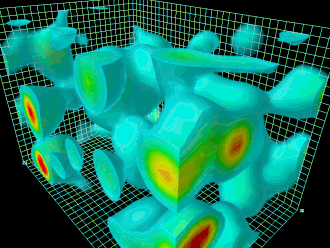Quantum fluctuation

In quantum physics, a quantum fluctuation (also known as a vacuum state fluctuation or vacuum fluctuation) is the temporary random change in the amount of energy in a point in space,<ref name="Pahlavani">Pahlavani, Mohammad Reza (2015). Selected Topics in Applications of Quantum Mechanics. BoD. p. 118. ISBN 9789535121268.</ref> as prescribed by Werner Heisenberg's uncertainty principle. They are minute random fluctuations in the values of the fields which represent elementary particles, such as electric and magnetic fields which represent the electromagnetic force carried by photons, W and Z fields which carry the weak force, and gluon fields which carry the strong force.<ref name="Pagels">Pagels, Heinz R. (2012). The Cosmic Code: Quantum Physics as the Language of Nature. Courier Corp. pp. 274–278. ISBN 9780486287324.</ref>
Vacuum fluctuations appear as virtual particles, which are always created in particle–antiparticle pairs.<ref name="Kane">Kane, Gordon (9 October 2006). "Are virtual particles really constantly popping in and out of existence? Or are they merely a mathematical bookkeeping device for quantum mechanics?". Sciences FAQ. Scientific American website, Springer Nature America. Retrieved 5 August 2020.</ref> Since they are created spontaneously without a source of energy, vacuum fluctuations and virtual particles are said to violate the conservation of energy. The disposition of this energy gap is not well-understood; some physicists believe that the energy is transferred to or from the macroscopic environment in the course of the measurement process, while others believe that the observable energy is only conserved "on average".<ref>"Puzzling Quantum Scenario Appears Not to Conserve Energy". Quanta Magazine. 2022. Retrieved 25 September 2022.</ref><ref name="Energy Non-conservation in Quantum">Carroll, Sean M.; Lodman, Jackie (August 2021). "Energy Non-conservation in Quantum Mechanics". Foundations of Physics. 51 (4): 83. arXiv:2101.11052. Bibcode:2021FoPh...51...83C. doi:10.1007/s10701-021-00490-5. S2CID 226664820.</ref> No experiment has been confirmed as definitive evidence of violations of the conservation of energy principle in quantum mechanics, but that doesn't rule out that some newer experiments, as proposed, may find evidence of violations of the conservation of energy principle in quantum mechanics.<ref name="Energy Non-conservation in Quantum"/>
The uncertainty principle states the uncertainty in energy and time can be related by<ref>Mandelshtam, Leonid; Tamm, Igor (1945). "Соотношение неопределённости энергия-время в нерелятивистской квантовой механике" [The uncertainty relation between energy and time in non-relativistic quantum mechanics]. Izv. Akad. Nauk SSSR (Ser. Fiz.) (in русский). 9: 122–128. English translation: "The uncertainty relation between energy and time in non-relativistic quantum mechanics". J. Phys. (USSR). 9: 249–254. 1945.</ref> <math>\Delta E \, \Delta t \geq \tfrac{1}{2}\hbar~</math>, where 1/2ħ ≈ 5.27286×10−35 Js. This means[citation needed] that pairs of virtual particles with energy <math>\Delta E</math> and lifetime shorter than <math>\Delta t</math> are continually created and annihilated in empty space. Although the particles are not directly detectable, the cumulative effects of these particles are measurable. For example, without quantum fluctuations, the "bare" mass and charge of elementary particles would be infinite; from renormalization theory the shielding effect of the cloud of virtual particles is responsible for the finite mass and charge of elementary particles.
Another consequence is the Casimir effect. One of the first observations which was evidence for vacuum fluctuations was the Lamb shift in hydrogen. In July 2020, scientists reported that quantum vacuum fluctuations can influence the motion of macroscopic, human-scale objects by measuring correlations below the standard quantum limit between the position/momentum uncertainty of the mirrors of LIGO and the photon number/phase uncertainty of light that they reflect.<ref>"Quantum fluctuations can jiggle objects on the human scale". phys.org. Retrieved 15 August 2020.</ref><ref>"LIGO reveals quantum correlations at work in mirrors weighing tens of kilograms". Physics World. 1 July 2020. Retrieved 15 August 2020.</ref><ref>Yu, Haocun; McCuller, L.; Tse, M.; Kijbunchoo, N.; Barsotti, L.; Mavalvala, N. (July 2020). "Quantum correlations between light and the kilogram-mass mirrors of LIGO". Nature. 583 (7814): 43–47. arXiv:2002.01519. Bibcode:2020Natur.583...43Y. doi:10.1038/s41586-020-2420-8. ISSN 1476-4687. PMID 32612226. S2CID 211031944.</ref>
Field fluctuations
In quantum field theory, fields undergo quantum fluctuations. A reasonably clear distinction can be made between quantum fluctuations and thermal fluctuations of a quantum field (at least for a free field; for interacting fields, renormalization substantially complicates matters). An illustration of this distinction can be seen by considering quantum and classical Klein–Gordon fields:<ref>Morgan, Peter (2001). "A classical perspective on nonlocality in quantum field theory". arXiv:quant-ph/0106141.</ref> For the quantized Klein–Gordon field in the vacuum state, we can calculate the probability density that we would observe a configuration <math>\varphi_t(x)</math> at a time t in terms of its Fourier transform <math>\tilde\varphi_t(k)</math> to be
- <math>\rho_0[\varphi_t] = \exp{\left[-\frac{1}{\hbar}
\int\frac{d^3k}{(2\pi)^3}
\tilde\varphi_t^*(k)\sqrt{|k|^2+m^2}\,\tilde\varphi_t(k)\right]}.</math>
In contrast, for the classical Klein–Gordon field at non-zero temperature, the Gibbs probability density that we would observe a configuration <math>\varphi_t(x)</math> at a time <math>t</math> is
- <math>\rho_E[\varphi_t] = \exp\big[-H[\varphi_t]/k_\text{B}T\big] = \exp{\left[-\frac{1}{k_\text{B}T} \int\frac{d^3k}{(2\pi)^3}
\tilde\varphi_t^*(k) \frac{1}{2}\left(|k|^2 + m^2\right)\,\tilde\varphi_t(k)\right]}.</math>
These probability distributions illustrate that every possible configuration of the field is possible, with the amplitude of quantum fluctuations controlled by Planck's constant <math>\hbar</math>, just as the amplitude of thermal fluctuations is controlled by <math>k_\text{B}T</math>, where kB is Boltzmann's constant. Note that the following three points are closely related:
- Planck's constant has units of action (joule-seconds) instead of units of energy (joules),
- the quantum kernel is <math>\sqrt{|k|^2 + m^2}</math> instead of <math>\tfrac{1}{2} \big(|k|^2 + m^2\big)</math> (the quantum kernel is nonlocal from a classical heat kernel viewpoint, but it is local in the sense that it does not allow signals to be transmitted),[citation needed]
- the quantum vacuum state is Lorentz-invariant (although not manifestly in the above), whereas the classical thermal state is not (the classical dynamics is Lorentz-invariant, but the Gibbs probability density is not a Lorentz-invariant initial condition).
A classical continuous random field can be constructed that has the same probability density as the quantum vacuum state, so that the principal difference from quantum field theory is the measurement theory (measurement in quantum theory is different from measurement for a classical continuous random field, in that classical measurements are always mutually compatible – in quantum-mechanical terms they always commute).